You won’t believe it!
The concept behind Mark Lengel’s Telemark Tech System binding is so simple it’s a wonder no one tried it before. Perhaps there was a quack or two out there who did and didn’t even believe it themselves, or they thought no one else would, so they abandoned it (after all, they’re quacks).It seems odd that the common view from backcountry’s religious sect know as telemarkers — who originally espoused light and simple gear for traveling in the mountains — would not recognize the value of the Dynafit system for enhancing a free heel. But as pinheaded telemarkers we didn’t – probably because telemarkers have been as poisoned and deluded with the bigger is better concept as much or more so than alpine skiers. Witness the trend in tele for phat skis, stiff 4-buckle monster boots and, consequently, heavy metal cable bindings.
As a tribe I can guarantee it’s going to take some time for pinheads to open their minds to the possibilities that the Tele Tech System (TTS) provides. However, when they do it will spawn a new generation of ski alpinists we’ve only been able to dream about until today.
But I digress here actually because what, at the moment, is most interesting to notice is how telemarkers have fallen prey to the same syndrome that most alpine skiers are duped by. Their eyes deceive them and they think that Dynafit or, more generically, Tech bindings simply aren’t strong enough to do the job. Their small size is undeniably the cause.
I remember the first time I spotted a pair. We were skinning up the west ridge of Baldy Bowl, on 10,040-foot San Antonio in 1990. I’d heard about these puny little bindings that the Euros were using when we chanced upon a guy wearing a pair. No one believed such a small binding could actually hold a man to a pair of skis.Ordinarily we’d just stare at any new gear we saw in the field since it was obvious the gear we used needed improvement. This time we stopped the guy and asked if he’d let us really look at ‘em. He knew exactly what we needed to see, so he disengaged and let us inspect ‘em up close. They were so small they defied belief. Indeed, from the get go that’s what Dynafit bindings do.
Even if they did hold, there’s no way they could provide any reasonable measure of release safety. The wearer admitted as much, but laughed it off by saying he hardly ever needed release and besides, as far as he could tell, they released whenever they should so he had no complaints. We figured he was just loopy ‘cuz he probably drank too much French wine and those Euros were funny anyway. Besides, there’s no way something that small could go the distance. It might be light and it might release exactly as he said but there was no way those things would last more than 30 or 40 days without breaking.
Such it seems is the instinctive reaction to Dynafit bindings. We think that for something to be strong it needs to be massive and beefy. Yet when you stop to consider other examples in life you realize that brute force is rarely the way to go, especially when there is a more elegant solution possible. So it is with Dynafit, replacing raw power with strategic power. It takes a while for your mind to accept it, which is why I’ve long maintained that Dynafit tests a man’s faith because you won’t see that it works until you believe that it works.Contrary to the popular myth that we believe in something after we have seen it, quite often you won’t see the value in something until you first believe it. Any man or woman who has a strong religious faith realizes the importance of that premise. It can literally turn your view of the world upside down, or in the case of the transformation of Ramer’s tuning fork release plate to a pair of Dynafit toe nipples — inside out. (early history of Dynafit here)
And this is the thing that is so ironic, since telemarkers have earned a reputation as religious zealots for proselytizing their manner of turning. Just as new backcountry converts have a hard time wrapping their head around the idea that a binding as small as the Dynafit can even keep you reliably attached to your ski let alone be more durable than a massive hunk like the Duke, telemarkers can’t believe the same things. That’s the problem when your belief gets watered down with sound bite dogma and you stop using your brain.
I’ve had similar ideas floating in my head for years but Mark Lengel made those ideas into drawings, then real pieces of material that incorporate the Dynafit toe with a tele cable. There is no doubt he also questioned the veracity of those steel nipples to hold a tele boot while flexing. Except he had enough faith to test if what he believed was really so. And I’m here to say, it’s a go. If you’re not sure, then I simply need to echo what I’ve told new turn earning alpine skiers for years – you just need to have faith that it really works.Despite being an ardent promoter of Dynafit to my locked heel friends, I shared your lack of confidence for the ability of such a small package to work for tele too. It just couldn’t possible be strong enough to hold your toe while cranking a tele turn, and certainly not repeatedly. But it only took a nudge from Mark Lengel for me to see it was possible and now that I’ve tried it, my belief in the Tech system as the future of bindings for ski alpinists is rather firm.
This use of tech toes for tele has me wondering about G3’s long term plans with Onyx too. Even if they are working on something for tele, rest assured this writer would be among the last people on earth G3 would share that information with. Therefore, their denial of a new tele binding can be categorically dismissed.Since it is very rare for any concept to be pursued by only one party at a time, I’m sure they’re playing with ways to make Onyx the do it all binding. I don’t think it is a coincidence that the toe and heel pieces slide on a nifty universal mounting track, or that the heel piece slides to the rear to disengage, something a switch hitter would want so they could free the heel or hold it tight, without having to exit the binding. Nor is G3 blind to the potential for NTN, especially for boots with a Tech fitting in the toe.
If you can reduce the weight of the tele side of the package to only two pounds by using a tech system toe, it isn’t asking that much to add back the weight of a rando-racing style heel for occasional pitches with a locked heel. No, this wouldn’t have the safety factor of a Duke, or even a Dynafit ST, but whenever I’ve wanted a locked heel, safety was defined by not releasing. Even teleheads who are weight conscious would be willing to carry 3 pounds if it offered vestiges of release and the ability to use a single rig that’s bi-sensual. Locked heel for when you want a firm foot to drive your edges or the sweet flex of a tele turn wherever you prefer it.
The Caveat
Now I don’t mean to be hypocritical here in acknowledging the fly in the ointment of my faith in Dynafit. There is one item that remains to be seen – the durability of a tech system toe subjected to telemark’s notoriously destructive forces over time. That it performs admirably on the tour and turning is no longer a question. How long it lasts before wearing out or breaking remains to be seen. The telemark turn stresses a binding more than a parallel turn, of that there is no doubt. However I remain confident that durability can be theoretically improved with a change in materials.
Conclusion
The recognition that a tech toe works as well in the tele realm as it does in the alpine, perhaps even better, is good news for those with an alpinist view, especially those who are bi-sensual.
© 2011
Related Articles
BackcountryTalk thread – TTS, strength, weaknesses, workarounds
Verdict on the TeleTechSystem binding

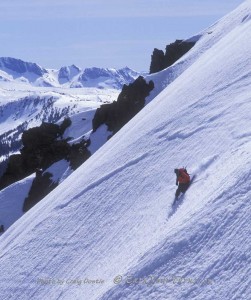
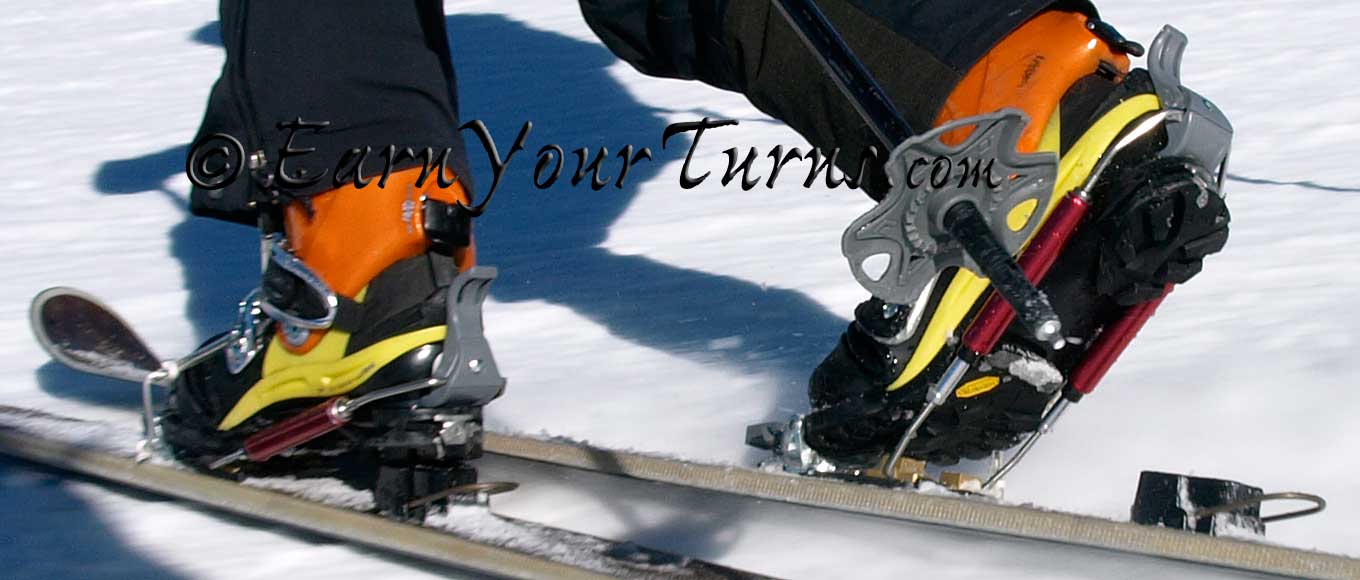
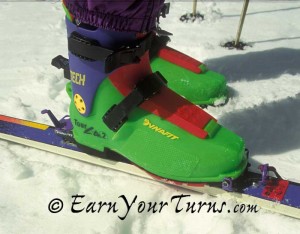
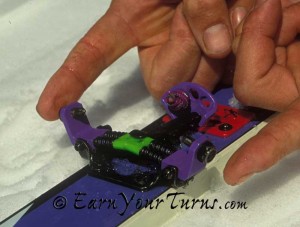
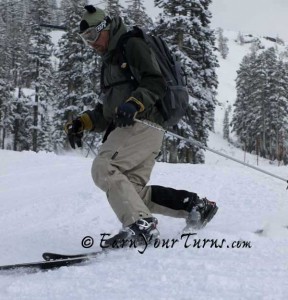
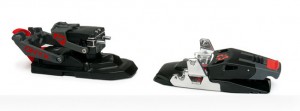
20 comments
4 pings
Skip to comment form
Guess it’s pretty obvious but a ntn binding with a tech toe would be da bomb! All you would need is a tech toe, a plastic underfoot plate (or maybe even just a metal wire) coupled to a long “under the binding” spring ala hammerhead. If you could use the skitrab TR2 toe you would have horizontal release, otherwise you would have to go with the ntn rollers at the second heel for release. Add the simplest tech heel and you would have a complete tele/at binding at maybe 200-300 g/binding. Coupled with the soft bellows of the ntn boots this would bee a touring dream.
I wouldn’t hold my breath while waiting for rottefella though. I think NTN has been put on the backburner, and rottefella don’t have the designers to make this thing come true anyway. Even more to the point, telemark bindings have been patented to death. BD has the patent for an “in front of the binding actuated touring release switch” and 22D has the patent for an under the foot spring.. I’m guessing at least 5 years before we’ll see a tech/ntn binding. 🙂
Author
re: Not holding my breath for Rottefella to come up with a light weight version of NTN with an acceptable touring ROM. Agreed. You’ll see a tech/NTN binding the very year the patent on using the 2nd heel expires. But I don’t think you’ll have to wait that long. A franken-tele rig that accomplishes the same thing shouldn’t be that hard to cobble together in a decent garage shop outfitted for metal working.
I am so ready for a telemark binding innovation, not complication.
A heel lockdown device coupled with a complicated toe plate would be heavy for sure.. I thinks its a good concept to add alpine style for versatility. This binding is headed in the right direction.
I would propose a lighter wedge type attachment on the heel to simply restrict lateral, not vertical movement, so I can mix in stronger alpine turns at any time with stopping to fidget with something. This gives you the ability to do both styles without stopping to lock heels. Not sure if a lock down is really needed considering todays heel retentive bindings (ie 01-superstiff.).
Yeah I would love to see what someone with a few tools and a lot of free time could come up with regarding a ntn/tech binding.
Pretty amazing that rottefella spent 10 years pushing the NTN project, designing patents, working with the boot manufacturers etc and right now they it seems like they are trying to put the entire project to sleep through non-innovation. What NTN got right was an AT toe, smoother flexing bellows, tech fittings and the idea that a tele binding should have release and brakes. The only thing holding the system back is pretty much the binding. Rottefellas idea of designing seems to be just adding grams..
This year I’ll probably be doing much more rando than tele. NTN’s doomed unless G3 or someone else can partner up with rottefella and design a lightweight tele binding.
Howdy!
I have a Beta-test set of these bindings that I got directly from the manufacturer… which at this time is Mark in his garage in SLC.
They ski great with some caveats…
My impression is based on two days of touring last week on Mt. Hood: some frozen/rime/boilerplate, some wind buff, some fast corn. 4000 plus vert each day.
I have put hundreds of days in on the Voile Switchback and the 22 D. Axl, both in the BC and as a full time Patroller.
I mounted the set up on a pair of K2 anti Pistes and used Binding Freedom inserts so I have two positions for the cable pivot point. I also mounted the set up directly to the ski and used an old Voile heel piece to get a totally flat ramp angle from heel to toe. This puts the boot about 15mm above the top sheet of the ski. I’m using a new 2012 Scarpa TX Pro boot in a size 25.5
The current set up has theoretical release with the G3 Cables. Bench tests, according to Mark are around DIN 13. I skied them with the toe in “ski mode” with no issues of pre release.
Caveats:
The stock G3 heel levers don’t create a good solid snap engagement as you have to place them on top of the heel platform and not into a groove on the boot heel. A specific heel lever is in the works. This did not seem to be an issue in use, however.
When flexing into a tele turn, the spring bottoms out in its travel inside the tube before your knee gets to the ski… For me, I reached a solid, hard stop with my knee about 9 inches off the top of the ski. In house springs are also in the works. I didn’t notice this while skiing, but I was on supportable surfaces, not in deep pow or moguls.
Durability? Any body’s guess at this point. Since the Dynafit patents are up, a specific toe piece for this system could be built addressing the durability issues.
Need to buy a new boot: Scarpa and Crispi (I think) are the only options.
Pros:
LIGHT!
Touring gives WAY more range of motion than any tele free pivot binding. That equals longer stride length and more efficiency
Easy in and out, especially the out. Just push on the toe lever and lift your boot up and forward.
Very solid feeling edge to edge.
Immediate engagement of the cable as you lift your foot, very easy and complete flexing of the bellows.
Very “connected” feeling in terms of being able to pressure the ski and edge the ski.
Potentially the most active binding out there, depending where you mount the pivot. I found that the recommended position feels more active than the Axl in position 3, possible akin to a Hammerhead 5 or more. In my optional forward position it feels like an AXL 2 or 2+.
Did I mention LIGHT?
Lastly, in terms of design evolution… Rottefella has a patent on bindings that interface with the NTN under arch “2nd heel” and they are not interested in liscensing that to anyone.
Furthermore, I believe that BD also has patents on under boot cable arrangements.
If a ski brake and step in heel could be developed, and it’s durable enough, this could be the ultimate binding… time will tell.
He has a few more beta test kits available and is interested in good feedback. Here’s a chance to participate in the evolution of the sport’s gear.
Bottom line?
This is an experimental binding that has tremendous potential. Lighter and just as active, at this point than any other binding. There are definitely issues that will need to be resolved.
@ Dostie and TTipers:
Been following the TTips debate (TTS Issues) on whether the tech toe/fittings will pre-release and whether they can contain “big skiing/skiers”.
So here’s the thing: if you know tech bindings you know that in tour mode (locked) they are hard pressed to release, hence the term “locked”. In a complete tech binding, heel and toe, in ski mode the toe release is dependent on the heel settings. Pre-release is sometimes a problem if the ski itself is arced or twisted sufficiently “between” the toe and heel to create excessive forces.
Because TTS does not use the tech heel and is skied with the toe locked, release is very unlikely under normal skiing conditions. Heel stability is important and there does seem to be some variance in lateral stability based on the amount of tension on the heel, the type of heel hook, and boot length/condition of fittings, etc…
It pains me to see folks stating their disbelief in TTS based solely on the assumption that the tech fittings “don’t seem like they would work”. Granted, this is not a cheap endeavor, buying into TTS or making your own TTS is expensive, but maybe in time a complete system with a TTS specific toe will become available.
Consider this: If it didn’t work, would Mark patent the idea? If it didn’t work, would an infamous NTN binding breaker be skiing them? If it didn’t work, then why are we having any discussion at all?
The big fail in all this is that no major brain trust was able to think of it first and now all the big boys are committed to a system that is heavy, fragile, etc…
I am now skiing two sets of TTS bindings, one based on the Axl and the other based on the HammerHead. These bindings work so well that I no longer ski any other binding and I’m in the process of converting some Crispi Evos to a tech toe; the Evo Rando is not available yet per Alpine Sports.
I will be in the Salt Lake City area for the week after New Years. If anyone is interested in trying my bindings, feel free to send me a message and I’ll make arrangements to meet.
Seeing is believing.
Anyone have any thoughts about mounting a TTS binding on Movement Logic-X skis and using Scarpa F1 Carbon boots.
Author
Besides being a pricey setup, it looks like a good combo. The carbon on the F1 is in the cuff so that shouldn’t affect the flex for tele. According to Mark Lengel, TTS developer, it takes a bit of time before an F1 can do a full, deep tele flex.
If you go for it, please let us know how it performs. The Logic-X looks like a great ski for earning turns – nice profile dimensions, nicer weight.
Pricey and very light. My main question is how this ski functions in the tele going down. Purported to be a very stiff board. Going up it is a no brainer. Like walking on water.
Author
If it’s like walking on water, then these boards require a whole lot more faith than even a Dynafit toe requires. 😉
If any of the folks using F1 boots with TTS are reading this, I am interested to know if you stayed with the thin stock liner or swapped out for a thicker more insulated and comfortable T2 or similar liner.
Craig, thanks for the informative site. I am thinking of constructing an alpine/tts binding. Can you or anyone compare F3s and TXs in terms of touring flex and bellows flex? I have never skied the overlap tongue on the TX, but the tongue on my T2Xs (same as f3) is way too stiff.
Also, does anyone know how the heel-to-tech toe fitting length compares for these two boots?
Thanks!
I currently ski a pair of first generation Scarpa TX (the stiffy) which I have modified by grinding and drilling to approximate the flex of a Crispi Shiver/Scarpa Comp. These boots work very well and I do not have any problems with my toes being crushed by the bellows. The only downside is that this boot is no longer available 🙁
While in SLC I was able to carpet test the Scarpa F1 and the Scarpa TX PRO 2012 model. The F1 was very soft in the bellows and seemed like a viable option until I dropped my knee to the ski, at which point the toe box collapsed on my toes! In speaking to Mark Lengel, he suggested that the F1 and F3 share a similar plastic and bellows/sole design, so these two boots may not be every skiers best choice.
I had better results when I tried the 2012 TX Pro. In the past the TX Pro had some bellows collapse where the upper bellows submarined under the lower bellows. This was not the case with the 2012 TX Pro, which seemed to handle knee to ski motion without toe box or bellows deformation. It seems as though the new TX Pro was stiffned up slightly over the previous model.
If I were picking a boot for TTS today, I’d aim for the TX or TX Pro. If I were looking toward next season, I’d get the Shiver Rando or Evo Rando. If I were looking to “build my own boot” I’d pick up some inexpensive used/demo Shivers or Evos and ADD a tech fitting to the toe. I am in the process of adding a tech fitting to my 2011 Green Evos, I’ll post a review once they are done 🙂
I have been using the TTS mounted on Kastle TX 87s for about a month now. The boot I choose is the Scarpa F1 Carbon. I am not a deep knee to board skier so the TTS/F1 limitations in this area is not an issue. I am using the Ski Trab TR-Race toe Mark is offering. G3 strap. Originally set this amazingly light weight rig up for skinning laps. Have found I like the system so much I am more and more using it for full days of lift skiing down. I have not been locking the toes at all. Have never pre-released. In the one applause garnering fall I have taken, one ski did release. Whether I hit the toe release lever or I just popped out I am not sure.
TTS is outstanding. At first getting into the TTS seemed pretty fussy. After I got the system down, of accurate snapping into the toe, it is now about on par with other bindings. Edge to edge is crisp and precise. Due to the pivot point location, shifting balanced weight between front to rear ski is outstanding. My next plan is to mount on my DPS 112 skis.
Will TTS bindings hold up to long term use? Who knows. Do other tele bindings hold up to a lot of use? Sure are a lot of people carrying around spare parts. Will I have a lot of fun sorting this question out, absolutely.
Unfortunately the F1 is not in the Scarpa lineup for next year. At least the Carbon version is an amazing boot. My experience with the F1 says a lot about where Scarpa could go with tele boots if TTS becomes a mainstream Telemark binding as I think it definitely should.
By the way I went a shell size up on the F1 in order to use an Intuition Tour liner. The liner that comes with the F1 Carbon is sort of a joke for anything outside of racing.
A bit of a lengthy post below – but it addresses a few posts above…
I have about 10 days this season (mostly backcountry, 3 lift days) on TTS bindings (normal Dynafit toe, G3 parts for the heel assembly), using both an F1 (normal, not race or carbon) boot and TX-Pros. Almost all with the F1s (because I like them).
The F1s telemark very well. For me, there is absolutely no toe-crunch or ‘bellows-collapse’ as Ben observed. So, it probably depends on your foot/boot and how low you go. You should be able to test that in advance. My guess is that if you set the pivot point on the TTS WAY back (e.g., the 7.5cm some recommend), that SUPER active binding just overpowers the boots. Especially if you telemark very low. [One of the challenges designing tele gear is the very wide range in people’s styles…]
I actually didn’t find the F1 flex to be all that different than the old T2/new T3 boots that the shell is obviously derived from. I was wondering if the bellows material would be different – but my (very very well used) F1s seemed familiar right away. Perhaps they are softer than new F1s would be – I don’t know. The F1s hike/tour wonderfully.
The problem with telemarking in F1s is that the large bump on the back of the boot for the cuff lock lever. That complicates a positive heel lever connection. Mark Lengel says his new heel levers are better, but he says even they don’t fit the F1 bump all that well. Fortunately, this is pretty easy to get around if you have a hacksaw and some sandpaper. I carefully cut off the top of a normal G3 lever so that it fits below the bump – and use a strap (attached using the screw on the lever) to give some leverage in popping it on. Works great.
TTS and F1 skiing performance has been excellent.
[My background: 25 years telemarking, 80% backcountry, and am a solid skier (tele instructor). I prefer a less active binding (normally skiing on G3s or BD O1s) using T2X boots.]
No matter what boot you use, a critical decision for anyone setting up TTS bindings is where to put the heelwire pivot point. Lengel’s new blocks give you a choice of positions which is fantastic. Kudos to him for that. His initial recommended setback of the tele pivot from the dynafit pin pivot was about 7.5cm. Some people testing variations and reporting online also concluded 7.5cm. Therefore, I started with that. For my size 8/9 shell boots, a 7.5cm set-back created FAR FAR too active a binding for my tastes. The binding controlled my foot – rather than the other way around. It was actually uncomfortable at times. Excellent power, but I didn’t like the feel. I swung my single-position risers around (I used inserts) so my second pivot point was at ~5cm back. Other tester reports seemed to dislike that – but for me, it actually still felt more powerful than a normal G3/BD binding (note that pivot distance is still further back than the pivot point on the G3/BD bindings… ). The TTS skis great for me there, although I will eventually try shifting it a bit further back (5.5 or 6cm)…
I would suggest that someone setting up a pair:
a) First mount your bindings on some 2x4s and experiment with how they feel before you mount them on skis. That only teaches you a little, but it is better than nothing.
b) If you are using Mark Lengel’s new 3-position riser/pivot blocks, consider locating them based on your skiing preference. Give yourself more range of options at the close end if you don’t like HIGHLY active bindings. If you love active bindings, push your options further back.
c) Consider your boot size. A very big boot will have the bellows further back… vice versa…
A quick comment about DavidNs: ” My experience with the F1 says a lot about where Scarpa could go with tele boots if TTS becomes a mainstream Telemark binding as I think it definitely should.”
I totally agree with David.
The combination of reasonably low weight and a very easy hinging cuff (and using back-hinging liners) makes the F1s tour better than any tele boot I’ve used (other than my old Asolo Snowpines!). It is somewhat frustrating that an AT boot that is clearly derived from the old T2/T3 last introduced improvements that still haven’t found their way back to telemark boots (5+ years later). I’m really hoping that the F1 line will find new life as a TX-Light boot and that some of the other cuff/lock innovations that have been so popular in AT boots make their way into tele boots.
In my opinion, the strong bias over the last 10 years towards lift-oriented, heavy tele gear has been misguided and counter-productive. I realize that the tele market is small and will always be small – but at least in western Canada, tele has always been driven by touring, not lifts/racing… I guess marketing studies showed otherwise, but that’s my opinion, it oughta be yours! ha! I hope telemarkers end up with at least a few TTS/F1-type options so they can enjoy the light/durable benefits that ATers have been reveling in the last couple of years.
When the “three pins” were first added to a ski binding, was it ridiculed? You bet it was, and yet it became the standard bearer and moniker for the telemark turn. Fast forward some decades, bindings have come and gone,, we now stand on the brink of a new age: TTS
…a telemark binding concept that throws down the gautlet and says, ENOUGH!, we want freedom, we demand freedom, freedom of the toe from the heel. Doesn’t drama just bring things to life 😉
The TTS concept is Mark Lengel’s baby and he deserves all of the credit for bringing this system to the masses. If not for Mark’s efforts I would not have explored TTS. That said, I have been skiing TTS exclusively for one year, all on bindings of my own design and construction. Through a process of trial and error, I now have two TTS bindings (TTS Axl and TTS Hammerhead) that qualify as the “holy grail” of telemark bindings:
Adjustable level of activity, mild to wild
Free pivot, 90 degrees with no resistance
Light weight, lighter than comparable free pivot bindings
Durable, no breakage in one year, that’s a first for me 😉
High ROM, knee to ski turns with spring to spare
Disaster release with variable settings
Brakes optional, ala La Sportiva.
Step in? Hey, no one’s perfect, but…
Does TTS work? Yes.
Is TTS expensive? Depends on your set up.
Is TTS reliable? So far it is very reliable.
Can I buy TTS off the shelf? Yes, give Mark a hollar: https://www.wasatchski.com/purchase.htm
Will TTS improve over time. Absolutely!
The real crux of TTS, and what seems to be missing from the discussion, is that the use of tech fittings/tech toe allows for secure boot retention without the need for “management” by a heel, second heel attachment, or toe bale. What this means is that any and all systems for creating “dynamic activity”, from mild to wild, are all accessible under the same TTS umbrella.
Next season, Scarpa will be joined by Crispi as a manufacturer of TTS ready telemark boots. In time Garmont may enter the fray. If our luck holds, lighterweight boots could be on the horizon, maybe an F1 Carbon or similar lightweight AT styled boot. Until then, just follow the old school way to lose weight, “cut, drill, grind”.
So, are you ready to embrace the two pin binding?
Author
I love it when folks get all fired up about gear. Not because of the gear but because of what the gear makes possible. That’s why so many alpine skiers became telemarkers – not because of the gear, but because of what they saw the gear made possible. A lot of those same people switched to Dynafit, not because they thought Dynafit was so cool (though it is), but because of what it made possible.
Why do we love backcountry skiing? Because of the freedom we experience while doing it that stands in such stark contrast to the never ending, ever expanding restrictions of the nanny states of Amerika. That and it’s FUN!
TTS fulfills the promise of a new telemark norm, where light weight, mountaineering versatility, and dowhill power are all available in one system. Now we just need some boots that provide the same range of motion that AT boots do, with the flex and comfort of tele.
And ‘they’ think tele is dead. “They” need to pull their heads out and see what’s going on!
Hear, hear!
[…] Dynafit goes bi-sensual. Can you believe it? The importance of adapting a Dynafit binding to work as an integral part of a telemark system. Source: http://www.earnyourturns.com […]
[…] F1 for those who chose to migrate to the NTN norm along the Dynafit style path illustrated by the Telemark Tech System (TTS), a hybrid NTN binding. Backcountry favors a free-pivot The Telemark Tech System […]
[…] Posts Spike TTS: Version 2.0, Mantis, Dynafit goes bisensual Rottefella’s NTN […]
[…] 2014 Related Posts Verdict on TTS Dynafit goes Bisensual Review of TTS v2.0 BCTalk Thread: TTS strengths, weaknesses, […]